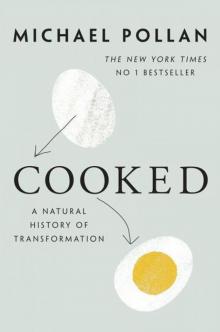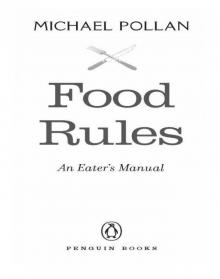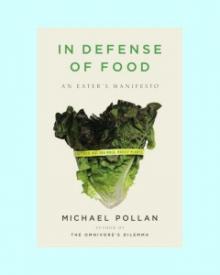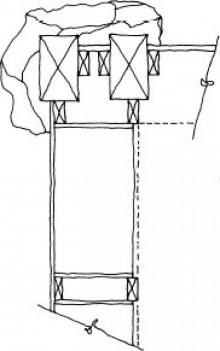- Home
- Michael Pollan
The Omnivore's Dilemma Page 3
The Omnivore's Dilemma Read online
Page 3
The government started seriously helping corn back in 1947. That was when a huge weapons plant in Muscle Shoals, Alabama, switched over to making chemical fertilizer. How can a weapons plant make fertilizer? Because ammonium nitrate, the main ingredient in many explosives, happens to be an excellent source of nitrogen. And nitrogen is one of the main ingredients in fertilizer.
After World War II, the government found itself with a tremendous surplus of ammonium nitrate. There was a debate about what the government should do with the leftover bomb material. One idea was to spray it on forests to help out the timber industry. But scientists in the Department of Agriculture had a better idea: Spread the ammonium nitrate on farmland as fertilizer. And so the government helped launch the chemical fertilizer industry. (It also helped start the pesticide industry, since insect killers are based on poison gases developed for the war.)
Chemical fertilizer was needed to grow hybrid corn because it is a very hungry crop. The richest acre of Iowa soil could never feed thirty thousand hungry corn plants year after year without added fertilizer. Though hybrids were introduced in the thirties, it wasn’t until farmers started using chemical fertilizers in the 1950s that corn yields really exploded.
THERE GOES THE SUN
When George Naylor’s father spread his first load of ammonium nitrate fertilizer, the ecology of his farm underwent a quiet revolution. Until then, the farm’s nitrogen had been recycled in a natural loop. Legumes used the sun’s energy to fix nitrogen in the soil. Other plants used the nitrogen to grow. Animals ate the plants and the farmer recycled the nitrogen by spreading the animals’ manure on the soil.
But now the Naylors didn’t need to produce their own nitrogen—they went out and bought it. The nitrogen for the fields would no longer be made with the sun’s energy but with fossil fuels. Farming was no longer an ecological loop—it was more like a factory. The farmer bought raw materials (seed and fertilizer) and turned it into a finished product—corn.
Since there was no need for legumes to fix nitrogen, farmers could plant corn in every field, every year. Animals and their pastures could be eliminated. Farming became much simpler. Like a factory, the industrial farm produces just one product (or at most, two).
And like most factories, the industrial farm is powered with fossil fuels. There’s the natural gas in the fertilizer and the fossil fuel energy it takes to make the pesticides, the diesel used by the tractors, and the fuel needed to harvest, dry, and transport the corn. Add it all up and you find that every bushel of corn from an industrial farm requires about half a gallon of oil to grow. That’s around seventy-five gallons of oil per acre of corn. (Some estimates are much higher.)
Source: University of Michigan Center for Sustainable Systems.
Here’s another way to look at it. Calories, like the calories in food, are units of energy. On the industrial farm, it takes about ten calories of fossil fuel energy to produce one calorie of food energy. That means the industrial farm is using up more energy than it is producing. This is the opposite of what happened before chemical fertilizers. Back then, the Naylor farm produced more than two calories of food energy for every calorie of fossil fuel energy invested. In terms of energy, the modern farm is a losing proposition. It’s too bad we can’t simply drink the petroleum directly—it would be more efficient.
The factory farm produces more food much faster than the old solar-based farm. But the system only works as long as fossil fuel energy is cheap.
NITROGEN POLLUTION
Hybrid corn eats up a lot of nitrogen, but farmers still feed it far more than it can possibly eat. In fact, farmers waste most of the fertilizer they buy. Many farmers put down extra just to play it safe. “They say you only need a hundred pounds per acre. I’m putting on closer to one hundred eighty,” Naylor explained to me, a bit sheepishly. “It’s a form of yield insurance.”
But what happens to the eighty pounds of man-made nitrogen that Naylor’s corn plants don’t take up? Some of it evaporates into the air, where it creates acid rain. Some of it turns into nitrous oxide, a gas that increases global warming.
Some of the extra fertilizer seeps down to the ground-water. Because of this, the Naylors don’t drink the well water on their farm. When I went to pour myself a glass of water in the kitchen, George’s wife, Peggy, made sure I used a special faucet connected to a water filter system.
Nitrogen, the most abundant element in the atmosphere, is necessary for life. The process by which nitrogen moves from the air to the soil and back again is called the nitrogen cycle.
As for the rest of the extra nitrogen, the spring rains wash it off Naylor’s fields, carrying it into drainage ditches. Eventually it spills into the Raccoon River. From there it flows into the Des Moines River, and down the Mississippi to the Gulf of Mexico. There, in a strange twist of nature, the fertilizer winds up poisoning the ocean. The flood of extra nitrogen causes a wild growth of algae, and the algae take up all the oxygen in the water, smothering the fish. The nitrogen runoff has creating a “hypoxic,” or dead, zone in the Gulf that is as big as the state of New Jersey—and still growing.
RICH FIELDS, POOR FARMERS
The industrial food chain makes some people very rich. Big agribusiness companies take in billions of dollars in profit. Yet one person who is not getting rich from the mountain of corn is the American farmer. George Naylor is all but going broke—and he’s doing better than many of his neighbors. His farm might feed 140 people, but it doesn’t support the four who live on it. They have a garden and some laying hens but don’t grow most of their own food. The farm doesn’t produce enough income to pay their bills. The family only gets by because of the paycheck George’s wife, Peggy, brings home from her job—and because of a subsidy check from the U.S. government.
If the American farmer is more productive than ever before, how come so many farmers are going broke? One morning, after George had his crop planted, I sat down with him at his kitchen table and we talked about the problem. The answer is a little complicated, but it boils down to this: The price of corn is kept low by government policies. The low price means there’s plenty of cheap corn for the industrial food chain. It means cheap animal feed to produce cheap meat and cheap high-fructose corn syrup for soft drinks. It means corn can stay king of the supermarket. But it also makes it hard for the average farmer to stay in business, even with government payments.
In the United States the price of corn is usually below what it costs to grow it. For example, when I visited George Naylor in 2005, it cost him about $2.50 to grow a bushel of corn. That cost includes things like fertilizer, seed, pesticide, and gas for the tractor and combine. But that year, the price the grain elevator co-op paid for a bushel of corn was only about $1.45. At that price Naylor would have lost more than a dollar on every bushel of corn.
With prices like that, how can Naylor and the other corn farmers stay in business? Because the government pays them part of the difference. In some years nearly half the income of America’s corn farmers comes from government checks. It is these government checks, or subsidies, that keep corn and soybean prices low. Yet the payments are never quite enough to cover expenses. That’s why Peggy Naylor has to have a job off the farm. That’s also why a lot of farmers go out of business or just give up and retire.
I asked George Naylor why he doesn’t grow something besides corn, and he laughed. “What am I going to grow here, broccoli? Lettuce?” The grain elevator is the only buyer in town, and the elevator only pays for corn and soybeans. The government will give payments to farmers for all the corn they can produce, but not for growing vegetables or fruit. Besides, Naylor has the equipment to plant corn and soybeans, he doesn’t have the equipment to grow that lettuce or broccoli—or anything else.
George Naylor finds himself in the same trap as all the other corn and soybean farmers in America. When prices fall, the only way they can stay in business is to find a way to grow even more corn or soy. One way is to boost yield per acre. That m
eans using more chemical fertilizer or maybe trying new hybrid or GMO seeds. Another way is to rent more farmland, maybe from your neighbor who has given up. After all, if you already have the tractor and machinery, it doesn’t cost much more to farm another 100 acres, or another 500.
This means bigger and bigger farms, worked by fewer farmers. It means more fertilizer pollution. And it means even more corn on top of the bulging mountain of corn. And that’s the catch. As farmers produce more corn, the price falls even more! Then the only thing an industrial farmer like George Naylor can do is try to grow even more corn. It’s a vicious circle. Prices go lower, but the mountain of corn gets higher and higher.
THE HIGH PRICE OF CHEAP CORN
Okay, so farmers like George Naylor are having a hard time. Everyone agrees that’s a bad thing. But isn’t this system still doing what it’s supposed to do? Doesn’t it produce cheap food for the American people? The problem is that government policies don’t really give us cheap food. It only gives us the kinds of cheap food made from corn and soy. Your soft drink or hamburger may be cheaper, but that’s because taxpayers have already paid for part of it. And that corn is only cheap if you don’t count all the hidden costs, like the cost of pollution from chemical fertilizers.
U.S. farm policy wasn’t always like this. Before the 1970s, government policy was designed to support small farmers, not agribusiness. Instead of trying to keep corn prices low, government farm policy was aimed at keeping food prices—and farmers’ income—stable.
Remember the law of supply and demand. If there is a lot of grain on the market, sellers have to compete with each other for customers. They lower their prices to try to sell their grain. If there is a shortage of grain, people will pay more for it. Then farmers can charge more for their crops.
Starting in the 1930s, during the Great Depression, the government began a policy to keep prices from rising or falling too much. That would protect consumers from having to pay too much for food. The policy would also protect farmers from going bankrupt if prices fell too much.
This is how it worked: In times when prices were low, the government gave farmers loans so they could store, rather than have to sell, their crops. It bought some grain to keep it off the market. It also paid some farmers not to grow grain. When prices were higher, farmers sold their grain and repaid the government. If prices were too high, the government sold some of the grain from its storehouses. That put extra grain on the market and brought the price down. This system worked pretty well for almost forty years.
AGRIBUSINESS, GOVERNMENT, AND CORN
Beginning in the early 1970s this system was thrown out the window. Now farm policy was aimed at one thing: keeping corn prices as low as possible. The government told farmers it would pay them for all the corn they could grow. To be exact— instead of the government buying all the extra corn, or loaning farmers money so they could store it, it just paid farmers part of the cost of growing it. So all the corn the farmers grew was put on the market, driving the price down. Farmers planted even more, corn prices began falling, and, with a few interruptions, they have been falling ever since.
Why did government policy change to favor growing more and more corn? Did corn somehow sneak into Washington and change the laws? No, even King Corn couldn’t do that. Instead, one of corn’s best friends did it. Big agribusiness corporations, the same ones that need cheap corn for their mills, helped write the very laws that set farm policy.
This is a farm policy that is not designed to help farmers. Lower corn prices drive farmers out of business. Small family farms get replaced with larger industrial farms. Meanwhile agri businesses like Cargill and Archer Daniels Midland (ADM) and food companies like Coca-Cola and McDonald’s make billions thanks to cheap corn and soy. This policy makes it cheaper to buy a corn-sweetened soft drink than whole vegetables, fruits, and grains. But most of all, this policy helps corn to take over our land, our food industry, and even our bodies.
4
THE GRAIN ELEVATOR
FOOD ON THE GROUND
One wet spring afternoon I visited the grain elevator in Farnhamville, Iowa. That’s where George Naylor hauls his corn each October. The sky was a soft gray, and it was drizzling lightly. My car rumbled across the railroad tracks.
Grain elevators are tall, hollow concrete tubes, like silos. They are the tallest buildings by far in this part of Iowa. You can see them for miles. But what stood out on this gray day was a bright yellow pyramid the size of a circus tent pitched near the base of the elevator. It was an immense pile of corn—left out in the rain.
The year before, farmers in the Midwest had had a bumper corn crop. It was too much for the elevators to handle, so some was just dumped on the ground. Even now, seven months later, there was still a huge pile. As I walked around it, I saw golden kernels everywhere, ground into the mud by tires and boots. Most of this grain is headed for factory farms and processing plants, so no one worries much about keeping it clean. Even so, it was hard not to feel that something was deeply wrong at the sight of so much food left out in the rain.
The next afternoon I met a Mexican American crop scientist named Ricardo Salvador, a professor at Iowa State University. He told me he’d had a similar reaction the first time he’d seen kernels littering Iowa roads in October. Farmers haul their corn to town in big open wagons that scatter a light rain of corn behind them. Salvador said the sight of so much corn on the ground made him feel sick. In Mexico, for thousands of years corn was honored as a source of life. Even today, he said, you do not let corn lie on the ground. To do so would be considered almost sinful.
Salvador’s reaction, like mine, came about because we were looking at corn the old-fashioned way, as a food. But the businesses that run the grain elevators and the industrial food chain do not look at corn as food. They look at it as a commodity, something to be bought and sold.
The corn at the grain elevator was not the same kind of corn you or I eat when we have corn on the cob. What George Naylor grows, and what was in the pile by the elevator, is a type called “number 2 field corn.” These kernels are hard to eat, but if you soak them in water for several hours you’ll find they taste like lightly corn-flavored starch. It is not a food for human beings. It is the raw material out of which the industrial food chain makes beef or chicken or high-fructose corn syrup or maltodextrin.
CORN THE COMMODITY
Before the railroads crossed America, corn was bought and sold in burlap sacks. More often than not the sacks bore the name of the farm where the corn had been grown. You could follow a sack from a farm in Iowa to the mill in Manhattan, where it was ground into meal, or to the dairy in Brooklyn, where it was fed to a cow. This made a big difference. Consumers knew who was growing their food. They knew exactly what it was and where it came from.
With the coming of the railroads and the grain elevator, the sacks suddenly became a problem. It is a lot easier to break the corn down into kernels and pump it, like a liquid, into the grain elevators and into the railroad cars. The sacks, and the names of the farms, had to go. Corn from hundreds of different farms was now mixed all together in a great golden river. The river of corn would flow from the farms to buyers anywhere in the world. Since the buyer couldn’t know whose corn they were purchasing, the Chicago Board of Trade made up a category called number 2 field corn. Any batch of number 2 corn was guaranteed to be as good as any other number 2 field corn.
THE RIVER OF CORN
At the height of the harvest the grain elevator in Farnhamville runs twenty-four hours a day, seven days a week. When George Naylor delivers his truckload of corn, it is weighed and graded and his account is credited with that day’s price per bushel. At that point it is no longer George Naylor’s corn—it becomes part of the vast river of corn flowing out of the Midwest toward your supermarket.
I watched a pile of corn pour into a railroad hopper car painted with Cargill’s blue and yellow logo. That car was joined to a train more than a mile long, holding 440,000 bu
shels of corn. Yet that number is a tiny fraction of all the corn produced in the United States. American farmers produce thirteen billion bushels of corn a year. (That’s up from four billion bushels in 1970.)
The supply of corn is usually far greater than the demand for corn, so new uses must be found for it all the time. People have to consume it in new ways, in new kinds of processed food. Animals that never ate corn before must be taught to eat it. We have to turn it into ethanol fuel for our cars. We have to get other nations to import it.
My plan when I came to Iowa was to somehow follow George Naylor’s corn on its path to our plates and into our bodies. I should have known that tracing a single bushel of industrial corn is as impossible as tracing a bucket of water after it’s been poured into a river. Making matters still more difficult, the golden river of corn is controlled by a tiny number of corporations. It has been estimated that Cargill and ADM together buy somewhere near a third of all the corn grown in America.
These two companies guide corn’s path every step of the way. They sell the pesticides and fertilizer to the farmers. They operate most of America’s grain elevators. They ship most of the corn exported to other countries. They mill the corn into its different parts to be used in processed food. They feed the corn to livestock and then slaughter the corn-fattened animals. Oh, yes—don’t forget that they also help write many of the rules that govern this whole game.

 A Place of My Own: The Education of an Amateur Builder
A Place of My Own: The Education of an Amateur Builder Cooked: A Natural History of Transformation
Cooked: A Natural History of Transformation The Omnivore's Dilemma
The Omnivore's Dilemma How to Change Your Mind
How to Change Your Mind Food Rules
Food Rules In Defense of Food
In Defense of Food A Place of My Own
A Place of My Own